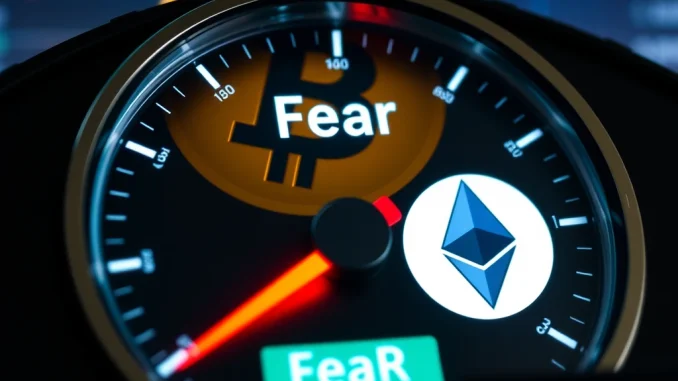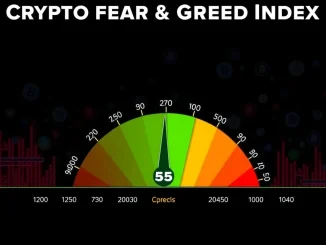
Navigating the volatile world of cryptocurrency requires more than just technical charts and market buzz. Understanding market sentiment is crucial, and the Crypto Fear & Greed Index is a vital tool in every crypto investor’s arsenal. Let’s dive into the latest readings and decipher what the current ‘Fear’ sentiment means for you.
Decoding the Crypto Fear & Greed Index: A Sentiment Thermometer
The Crypto Fear & Greed Index, a creation of Alternative.me, serves as a gauge of market emotions. Think of it as a sentiment thermometer for the crypto market. It’s designed to distill the complex emotions of the crypto market into a single, easily digestible number ranging from 0 to 100. A score of 0 indicates ‘Extreme Fear’, suggesting investors are overly worried and potentially selling off their assets. Conversely, a score of 100 represents ‘Extreme Greed’, signaling excessive optimism and a potential market bubble.
As of March 25th, the index stands at 46. This is a slight uptick of one point from the previous day, but crucially, it remains firmly within the ‘Fear’ zone. This indicates that while there’s a marginal improvement in sentiment, a prevailing sense of caution still grips the crypto market.
Why Does Market Sentiment Matter in Crypto?
The cryptocurrency market is known for its rapid fluctuations and sensitivity to news and global events. Unlike traditional markets, the crypto space is heavily influenced by investor sentiment, which can drive significant price swings. Understanding the prevailing mood – whether it’s fear or greed – can offer valuable insights into potential market movements.
Here’s why tracking market sentiment is beneficial:
- Identify Potential Buying Opportunities: Extreme fear can sometimes present golden buying opportunities. When the index is low, it might suggest that assets are undervalued due to panic selling. Legendary investor Warren Buffett’s advice, “Be fearful when others are greedy and greedy when others are fearful,” resonates strongly with this concept.
- Recognize Potential Selling Signals: Conversely, extreme greed can be a warning sign of an overheated market. High index values might indicate a potential bubble, suggesting it could be a prudent time to take profits or reduce exposure.
- Gauge Market Volatility: The index itself incorporates volatility as a factor. Higher fear often correlates with increased volatility, while periods of greed can sometimes precede market corrections.
- Enhance Trading Strategies: Incorporating the Fear & Greed Index into your trading strategy can provide an additional layer of analysis, helping you make more informed decisions beyond just technical and fundamental analysis.
Decoding the Index: The Six Pillars of Sentiment Analysis
The Crypto Fear & Greed Index isn’t based on guesswork. It’s a data-driven tool that aggregates information from six key sources to provide a comprehensive view of market sentiment. Let’s break down these factors:
| Factor | Weightage | Description |
|---|---|---|
| Volatility | 25% | Measures the current and maximum drawdowns of Bitcoin, comparing it with the corresponding average values of the last 30 and 90 days. Unusually high volatility is often a sign of fear. |
| Market Momentum/Volume | 25% | Analyzes market momentum and volume in relation to the last 30 and 90-day averages. High buying volumes on a daily basis are often interpreted as a greedy market. |
| Social Media | 15% | Primarily focuses on sentiment analysis from Twitter. It tracks hashtags, engagement, and the speed and interaction rates to gauge public opinion on crypto. |
| Surveys | 15% | Weekly crypto polls are conducted with a large sample size to understand investor sentiment directly. This provides a more direct measure of fear and greed. |
| Bitcoin Dominance | 10% | An increase in Bitcoin dominance might be a sign of fear, as investors often move funds from altcoins to Bitcoin in uncertain times, seeking the perceived safety of the flagship cryptocurrency. |
| Google Trends | 10% | Analyzes Google Trends data for Bitcoin-related search queries. Increased search volumes can indicate either growing interest (greed) or concern (fear), depending on the context and other factors. |
The ‘Fear’ Zone: What Does it Mean for Crypto Investors?
The current reading of 46, placing the index in the ‘Fear’ zone, suggests a cautious outlook among crypto investors. It’s not ‘Extreme Fear’, which would be below 25, but it’s still indicative of uncertainty and potential hesitancy in the crypto market.
Here’s what the ‘Fear’ zone might imply:
- Potential Market Consolidation: Fear can lead to reduced trading activity and market consolidation as investors become more risk-averse and wait for clearer signals.
- Opportunity for Strategic Accumulation: For long-term investors, the ‘Fear’ zone can be an opportune time to strategically accumulate crypto assets, especially if you believe in the long-term potential of the technology and specific projects.
- Increased Volatility Risk: While fear can sometimes precede market downturns, it can also create periods of heightened volatility. Be prepared for potential price swings and manage your risk accordingly.
- Focus on Due Diligence: In times of fear, it’s even more crucial to conduct thorough research and due diligence before making any investment decisions. Don’t let fear-driven narratives sway you without understanding the underlying fundamentals.
Actionable Insights: Navigating the Current Market Sentiment
So, what should crypto investors do with this information? Here are some actionable insights:
- Stay Informed, But Don’t Panic: The Crypto Fear & Greed Index is a useful tool, but it’s just one piece of the puzzle. Stay informed about broader market trends, news, and developments, but avoid making impulsive decisions based solely on fear.
- Review Your Portfolio: Assess your current crypto portfolio in light of the prevailing ‘Fear’ sentiment. Are you comfortable with your risk exposure? Is your portfolio aligned with your long-term investment goals?
- Consider Dollar-Cost Averaging (DCA): If you believe in the long-term potential of crypto, consider employing a dollar-cost averaging strategy. This involves investing a fixed amount of money at regular intervals, regardless of price fluctuations, which can help mitigate the risks of market volatility, especially during periods of fear.
- Educate Yourself: Use periods of market uncertainty to deepen your understanding of the crypto space. Learn about different projects, technologies, and market dynamics. Knowledge is your best defense against fear-driven decisions.
Conclusion: Embrace Calculated Caution in the Crypto Landscape
The Crypto Fear & Greed Index at 46, remaining in the ‘Fear’ zone, serves as a reminder of the inherent volatility and emotional nature of the cryptocurrency market. While ‘Fear’ might sound negative, it also presents opportunities for astute investors. By understanding how to interpret the index and integrating it with your broader investment strategy, you can navigate the crypto landscape with calculated caution and potentially capitalize on market fluctuations. Remember, informed decisions, not emotional reactions, are the key to success in the exciting yet unpredictable world of crypto.



